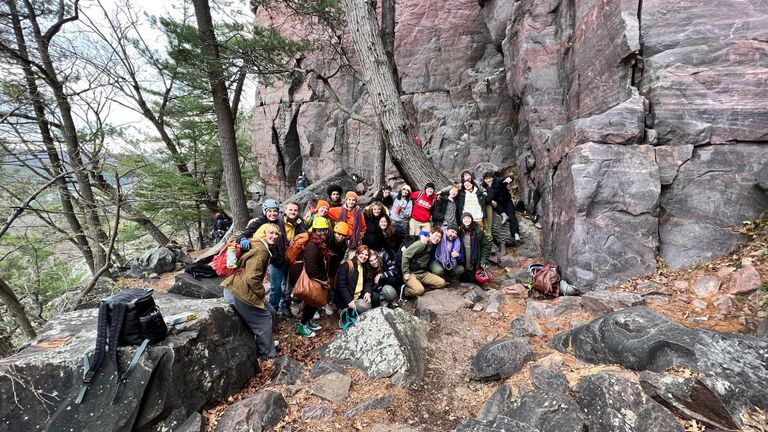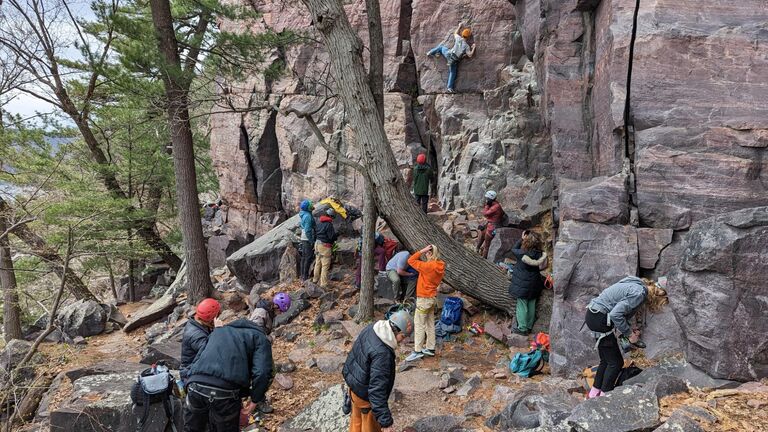
Conquering New Heights
At the age of 11, Carmela Murphy (BFA 2024) impulsively climbed up the walls of a changing room at Talbots. No amount of coaxing could bring her back down. After finally retrieving her daughter from the elevated hideout, Murphy's mother took her straight to the nearby climbing gym. Since that day, Murphy has dedicated countless hours to climbing. She has always felt the encouragement of the climbing community at the local gym, and was eager to bring this same energy to the School of the Art Institute of Chicago (SAIC). The combined efforts and aspirations of Murphy, along with a dedicated group of passionate climbers at the School, led to the establishment of the SAIC Climbing Club. Originally thought of as a niche interest, the club has since evolved to become a source of inspiration driving change across the campus.
Established in the spring of 2021, the SAIC Climbing Club instantly gained momentum, becoming one of the fastest-growing clubs on campus. Today the club unites more than 200 members around the core of over 50 dedicated participants attending every practice. It has become a platform, allowing the School’s creatives to express themselves through movement.
Murphy assures that art school practices and climbing are more connected than one might think. She points out that various communities at SAIC such as queer, neurodivergent, and disabled individuals have historically been excluded from sports. “We don’t have a sense of community or belonging in sports,” elaborated Murphy. “Neither do we have ways to move comfortably or feel good about our bodies and what they allow us to do. Climbing is just such a beautiful way to express yourself and move your body in a really creative way.”
Many young creatives seek an inclusive community, healthy stress relief strategies, and a break from the containment of artmaking. “I have very bad fits of seasonal depression during which I tend to close myself off in the winter,” explained club member Nick Atwood. “Having the club to not only get me out of the house, but around other people has been a real lifeline.”
The club invites students to participate in various types of core activities like regular climbing and strength practices, monthly movie nights, and trips to Devil’s Lake in central Wisconsin to practice in the wilderness. The club has purposefully chosen bouldering—climbing without ropes—as a focal point to cultivate a tight-knit and supportive community. Besides physical training, bouldering requires devising a potential climbing route before making the first step towards the wall, which is also known as beta. “If you consider each climb a puzzle, beta is its answer–its solution,” said Murphy. “Even if you’re not strong enough to do a climb, you can figure out the puzzle and envision how your body is supposed to move.”
Murphy acknowledged that this type of climbing may be daunting for newcomers. Nevertheless, she believes that with the proper guidance and a cheering crowd below, one can overcome any obstacles. “It’s hard not to cheer for a stranger at the gym. The feeling of support is resounding and infectious,” said Jordan Gantos, another of the club’s members.

Beyond the club's athletic pursuits, members also participate in social initiatives. “At a time where trans rights are actively being taken away, having this space where people can compete and move their bodies as themselves is crucial,” Murphy said. The club's co-president, June Thomas (BFA 2025), is developing new inclusivity and accessibility programs for queer and trans individuals, ensuring everyone feels welcome and supported.
Besides keeping up with the regular agenda, a major initiative for this year will be the introduction of a program for competitive climbing, providing opportunities for members to participate in USA Climbing qualifiers and regional competitions. Additionally, the club is working on organizing an outdoor adventure camp. In order to account for these ambitious plans, students are proposing the introduction of a separate budget allocated specifically for movement-based clubs. Such redistribution would allow the club to cover essential expenses such as transportation, housing, and competition entry fees. “As someone who has always been a part of a sports team, the lack of them at SAIC has always been its greatest shortcoming in my mind,” said member Chloe Dalton. “The club has already been so amazing at building a community and I’m confident having a team would expand it.”
Altering the traditional perception of a student organization on campus, the SAIC Climbing Club has become more than just a sports group—it is a hub for innovation, a social platform, and an empowering lifestyle.
“I can now say that I am part of a community that is fun to be around, kind, caring, supportive, and we all love to climb up walls,” shared Jordan Gantos. “I love this club with my whole heart.”



